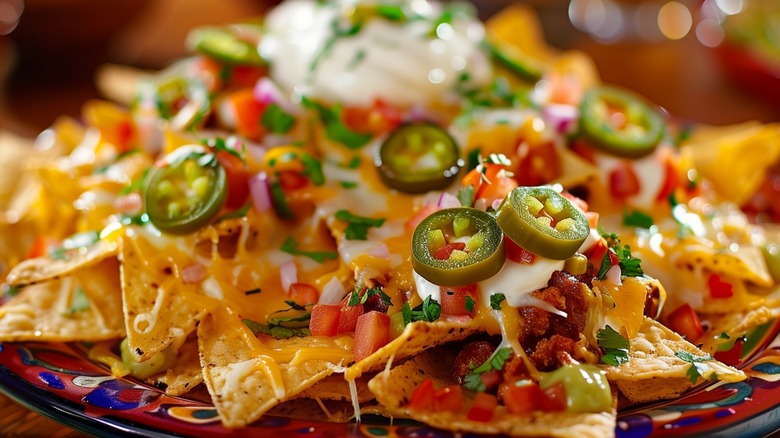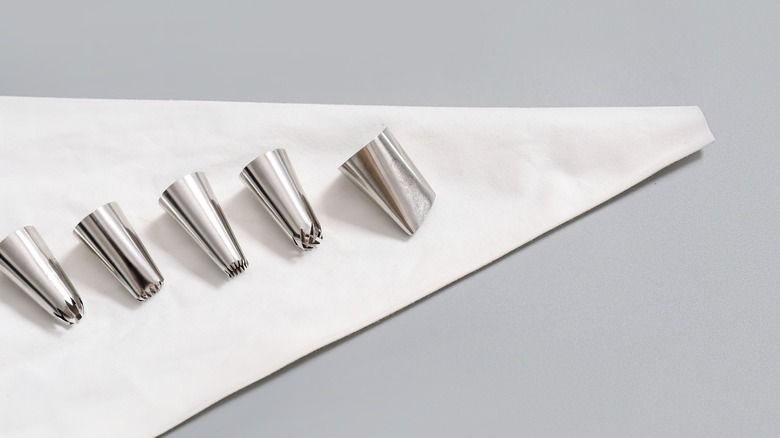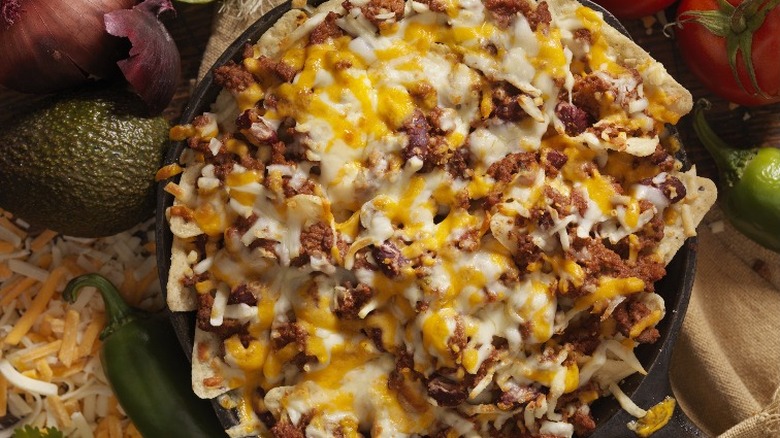This Refried Bean Mistake Is Probably Ruining Your Homemade Nachos
Your nachos — and the nachos of most restaurants you've ever been to — probably suck. There's a pile of chips on the plate followed by a (somehow) volumetrically similar blob of toppings led by refried beans. And eaters are supposed to figure out how to get a delicious, balanced bite with half the chips naked and the other half saggy and soggy under the weight of beans.
There's a better way, and it starts with the right way to apply the refried beans, which is to each individual chip. If that sounds time-consuming, that's because it can be. But there's a hack to make it almost as fast as just plopping it on, no matter which refried bean recipe you choose: a piping bag.
Piping your refried beans onto your nachos results in an even layer of toppings and a harmonious distribution of flavors without having to assemble them as you eat. And since each chip is only burdened with as much weight as it can realistically carry, you also avoid a layer of chips of compromised texture atop the crispy, undressed ones.
Preparing your refried beans for piping
Whether you use your grandmother's recipe for refried black beans or pop open a can of a grocery store sale find, texture is crucial. They must be smooth enough to come out without clogging but thick enough to stay put. And they must be warm when you test them so you can get an accurate idea, so you may as well upgrade your canned refried beans while you heat them.
If yours are too thick, splash in small amounts of water or stock until they're the right consistency. If they're too runny, you have a couple of options. You can cook them uncovered over medium heat, smashing them a bit more, until some of the liquid evaporates and the starch from the smashed beans thickens the mixture. Or you can add a slurry of equal parts cornstarch or flour and water and cook that until the mixture thickens and you don't taste raw thickener.
Allow the beans to cool slightly before spooning them into a piping bag, either fitted with a medium or large tip or tipless. Silicone piping bags are nice because they protect your hands from the heat, but you can also use a disposable piping bag or even a freezer bag with tight-fitting gloves (so you still have dexterity) or a clean towel. If necessary, cut off the tip of the bag large enough for the piping tip, or about three-quarters of an inch if you're not using one.
Tips for perfect layers of bean nachos
Lay the nacho chips out in a single layer on a baking sheet or casserole dish. Then, use the piping bag to put a thin layer of beans on them. It doesn't need to be attractive. You're just looking for a thin, even layer. You don't have to use them all up. There are plenty of ways to use up refried beans. Although, you can do a second layer after adding toppings to the first if you like. You might even be able to get away with a third.
Laying the chips out in layers and keeping the bean layer thin gives you easy access to every chip, ensuring each one gets just enough beans for its size and that every chip has something on it. As a bonus, it makes it easier to distribute the rest of your toppings, such as jalapeños and cheese. Speaking of cheese, making that the last topping on each layer can help protect your carefully beaned nachos from the excess moisture that leads to sogginess, which is important if you go to all this trouble. And when it all comes out of the oven, every chip is lightly toasted on the edges. You can put condiments and additional toppings on when they come out of the oven if you'd like to make it look more appetizing. Whatever you do, the only way to ruin them now is by forgetting your favorite topper.


